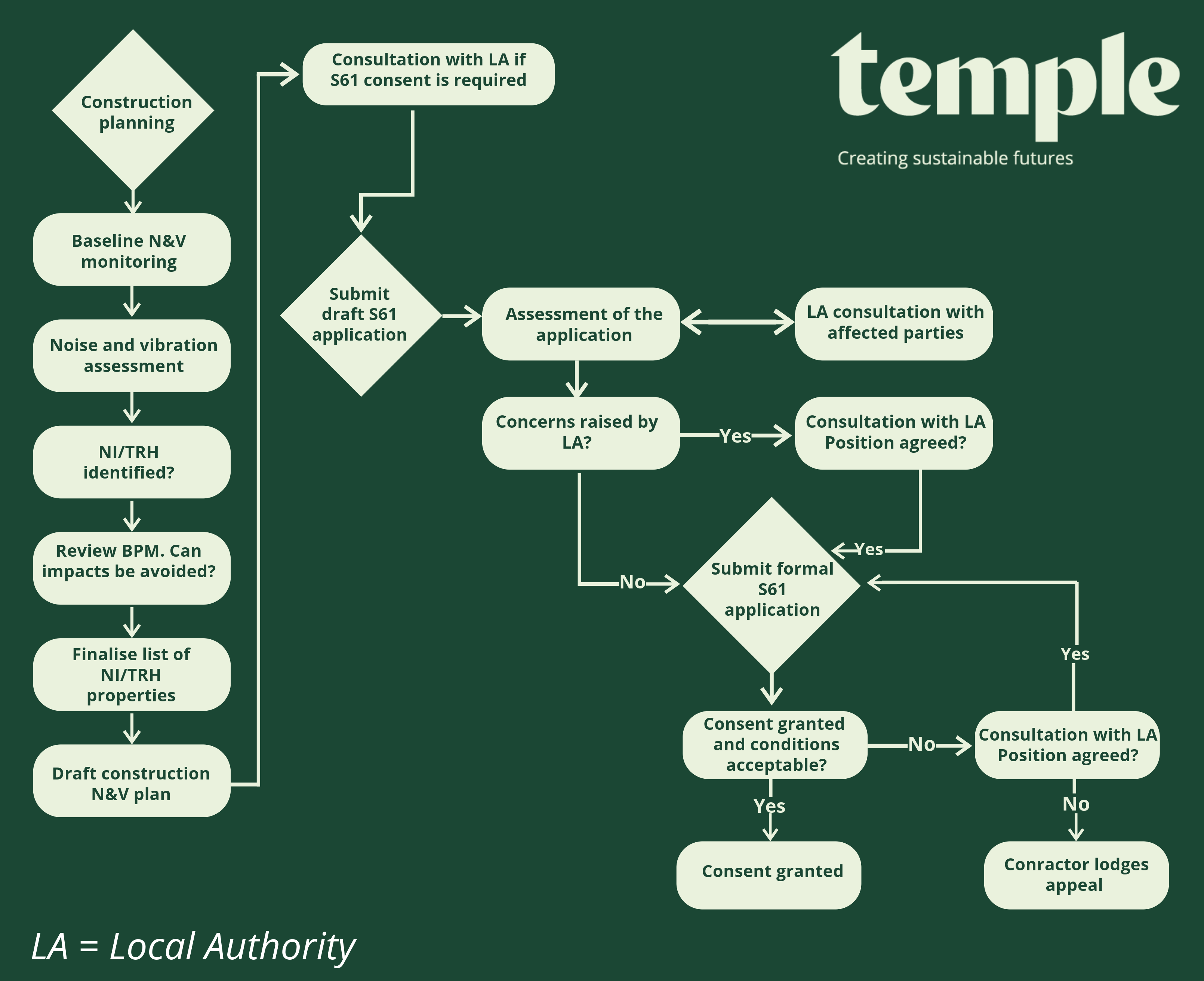This website uses cookies so that we can provide you with the best user experience possible. Cookie information is stored in your browser and performs functions such as recognising you when you return to our website and helping our team to understand which sections of the website you find most interesting and useful.
Our discussion on Section 61 consent, continues with the following details the procedural complexities involved in securing this document for construction and demolition projects, emphasising the collaborative efforts of contractors and Local Authorities (LAs) to manage noise and vibration impacts on the surrounding community.
Section 61 Consent Process

The above flowchart presents a typical process of obtaining Section 61 consent.
Based on location, type of work, duration, working hours, and potential noise/vibration impact, the proposed construction or demolition work may require Section 61 consent. Consultation with the LA would inform whether Section 61 consent is recommended for a specific site. For large-scale and long-term development or work with a particular risk of higher impact (such as night work or increased noisy activities), contractors are advised to seek Section 61 consent under the Control of Pollution Act 1974 (CoPA) with the principal contractor being primarily responsible. Section 61 consent benefits contractors and LAs in controlling and mitigating noise/vibration impacts, allowing agreed standards and effective work management. Obtaining Section 61 consent and compliance help contractors avoid action under CoPA or the Environmental Protection Act (EPA), as long as the contractor is working within the agreed Section 61 conditions. Note: Section 61 consent does not prevent an individual from taking private action against a contractor for noise nuisance under Section 82 of the EPA.
Securing Section 61 consent typically involves three stages: preparatory, draft (informal), and final (formal statutory process).
Preparation
The application should include items such as:
- work details
- location
- working days/hours
- equipment information
- noise/vibration potential
- proposed mitigation measures
Required documentation may include site plans, identification of stakeholders, methodology, programme of works, noise/vibration assessments, measurements, contour maps, and proposed mitigation measures to ensure compliance with regulations.
Draft Submission
During the Draft Application stages, the LA assesses the application and may consult affected parties for feedback on proposed mitigation measures. Submitting a Draft Application allows realistic and attainable conditions, reducing surprises upon final consent and minimising the need for costly and time-consuming formal appeals. A noise and vibration monitoring program is often necessary to demonstrate compliance with Section 61 consent.
Formal Submission
The formal application would be submitted after consultation and agreement on the proposed mitigation measures. The formal application should detail consultations with affected parties, including residents and businesses, and provide information on any feedback received during the process. The application should outline proposed monitoring and reporting requirements details of which must be agreed upon in advance with the LA. The LA would then assess the application and decide whether to grant or refuse Section 61 consent based on factors like potential impact, proposed mitigation measures, and feedback received during the consultation. Once the consent is granted, the applicant is responsible for ensuring that all works comply with the Section 61 consent terms. It should be noted that the LA Environmental Health Officers may request additional monitoring if complaints arise. The applicant can appeal the Council’s decision if they decide to refuse the application or if the applicant does not agree with some aspect of the consent notice terms (such as a condition which they believe to be unreasonable or impossible to achieve having regard to Best Practicable Means).
For further information on the Section 61 application process, noise and vibration prediction or monitoring, or to discuss applying for consent, please feel free to reach out.
You can also learn more about our approach to large-scale and long-term developments that require numerous consents here:
HS2 early works construction modelling on large-scale demolition works
The extension of the northern line enabling regeneration of Vauxhall, Nine elms and Battersea
